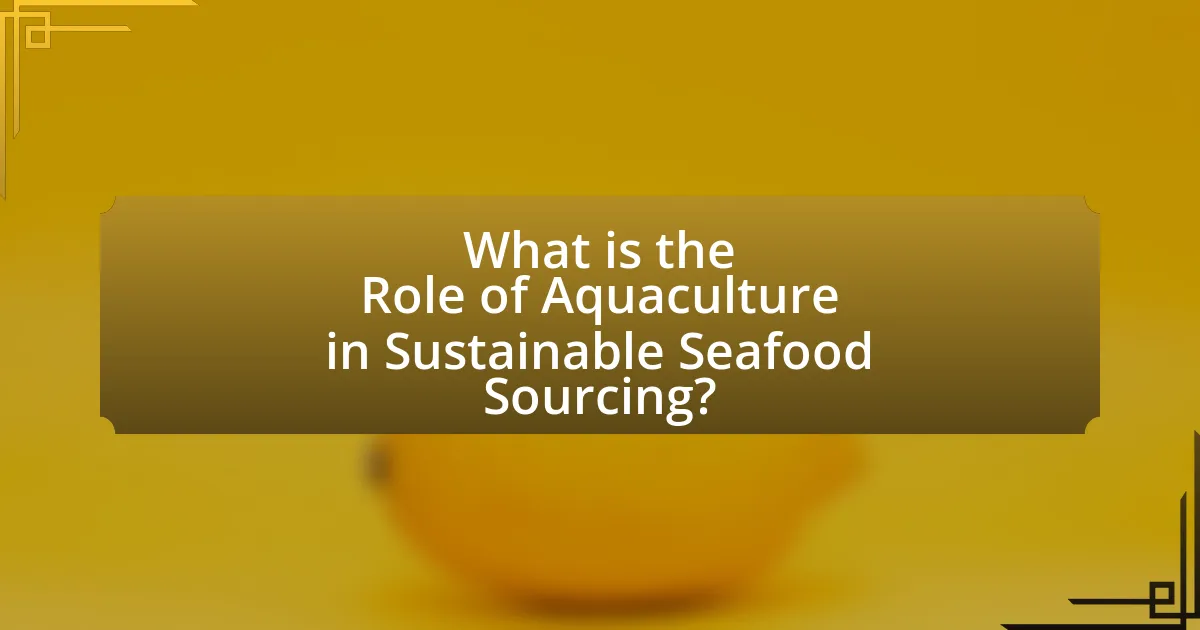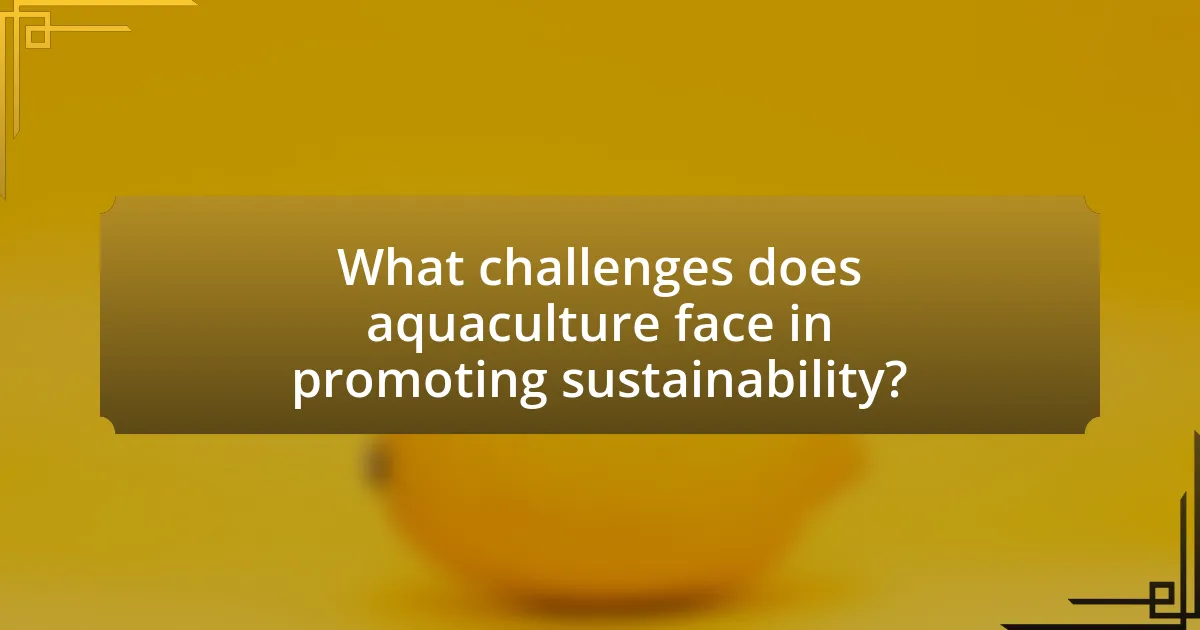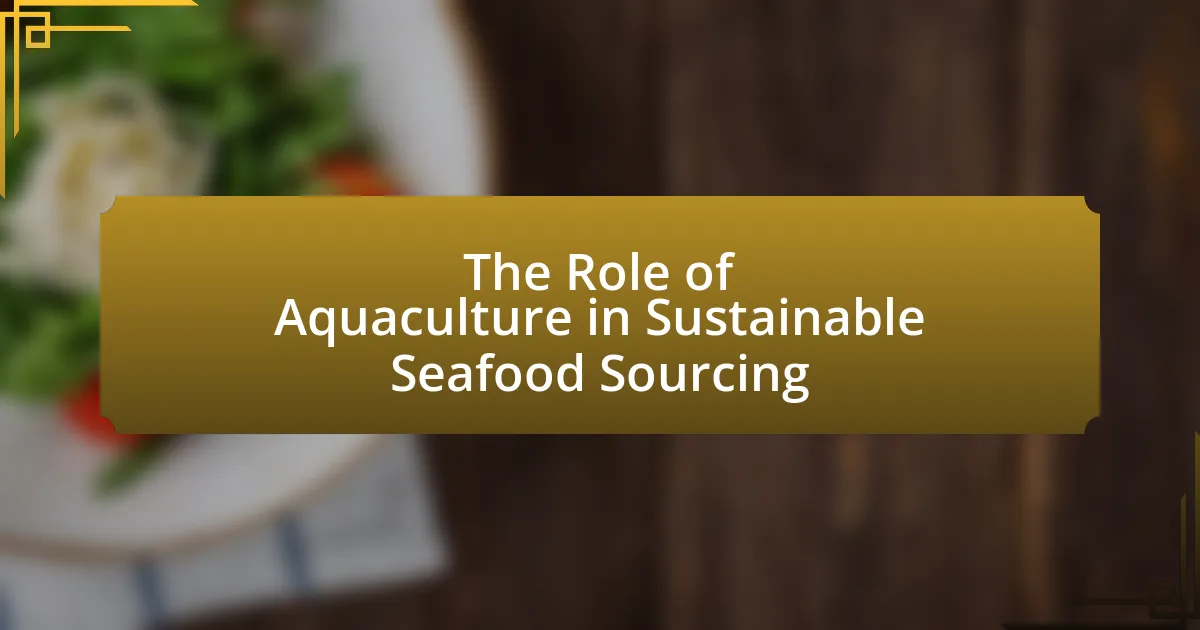Aquaculture is a vital component of sustainable seafood sourcing, providing a controlled environment for the cultivation of fish and shellfish, which alleviates pressure on wild fish populations. This article examines the role of aquaculture in meeting global protein demands while minimizing overfishing and habitat destruction. Key practices promoting sustainability, such as integrated multi-trophic aquaculture (IMTA) and responsible feed management, are discussed, along with the environmental impacts of unsustainable seafood sourcing. Additionally, the article highlights the economic benefits of sustainable practices for local communities and the challenges faced by aquaculture in promoting sustainability. Innovations in aquaculture technology and best practices are also explored, emphasizing their importance in reducing the ecological footprint of seafood production.

What is the Role of Aquaculture in Sustainable Seafood Sourcing?
Aquaculture plays a crucial role in sustainable seafood sourcing by providing a controlled environment for the cultivation of fish and shellfish, which reduces pressure on wild fish populations. This method of farming seafood can help meet the growing global demand for protein while minimizing overfishing and habitat destruction associated with traditional fishing practices. According to the Food and Agriculture Organization (FAO), aquaculture accounted for 46% of global fish production in 2020, highlighting its significance in ensuring food security and sustainability. By implementing responsible farming practices, such as using sustainable feed and maintaining water quality, aquaculture can contribute to the conservation of marine ecosystems while supporting local economies.
How does aquaculture contribute to sustainable seafood sourcing?
Aquaculture contributes to sustainable seafood sourcing by providing a controlled environment for fish and shellfish production, which reduces overfishing of wild stocks. This method allows for the cultivation of species in a manner that minimizes environmental impact, as it can be managed to prevent habitat destruction and pollution. According to the Food and Agriculture Organization (FAO), aquaculture accounted for 46% of global fish consumption in 2020, demonstrating its significant role in meeting the growing demand for seafood while alleviating pressure on wild populations. Additionally, sustainable aquaculture practices, such as integrated multi-trophic aquaculture (IMTA), enhance ecosystem health by recycling nutrients and promoting biodiversity.
What are the key practices in aquaculture that promote sustainability?
Key practices in aquaculture that promote sustainability include integrated multi-trophic aquaculture (IMTA), responsible feed management, and habitat protection. IMTA involves cultivating different species together, allowing waste from one species to serve as nutrients for another, thus enhancing resource efficiency. Responsible feed management focuses on using sustainable feed sources, reducing reliance on wild fish stocks, and optimizing feed conversion ratios to minimize environmental impact. Habitat protection ensures that aquaculture operations do not harm local ecosystems, maintaining biodiversity and water quality. These practices collectively contribute to reducing the ecological footprint of aquaculture and ensuring long-term viability of seafood sourcing.
How does aquaculture reduce pressure on wild fish populations?
Aquaculture reduces pressure on wild fish populations by providing an alternative source of seafood that alleviates the demand for wild-caught fish. By cultivating fish and other aquatic organisms in controlled environments, aquaculture helps to meet consumer needs without depleting natural fish stocks. For instance, global aquaculture production reached over 114 million metric tons in 2020, significantly contributing to the overall seafood supply and allowing wild fish populations to recover from overfishing. This practice not only supports biodiversity but also promotes sustainable fishing practices by reducing the reliance on wild fisheries, which are often subject to strict regulations and declining stocks.
Why is sustainable seafood sourcing important?
Sustainable seafood sourcing is important because it ensures the long-term viability of fish populations and marine ecosystems. Overfishing and destructive fishing practices have led to significant declines in fish stocks and biodiversity, threatening food security and the livelihoods of communities that depend on fishing. According to the Food and Agriculture Organization, approximately 34% of global fish stocks are overfished, highlighting the urgent need for sustainable practices. By prioritizing sustainable sourcing, consumers and businesses can support responsible fisheries and aquaculture, which helps maintain healthy oceans and promotes economic stability in fishing communities.
What are the environmental impacts of unsustainable seafood sourcing?
Unsustainable seafood sourcing leads to significant environmental impacts, including overfishing, habitat destruction, and biodiversity loss. Overfishing depletes fish populations faster than they can reproduce, resulting in the collapse of fish stocks; for instance, the United Nations Food and Agriculture Organization reported that 34% of global fish stocks are overfished. Habitat destruction occurs through practices like bottom trawling, which damages ocean floors and disrupts marine ecosystems. Additionally, unsustainable sourcing contributes to biodiversity loss, as the removal of key species can destabilize entire ecosystems, evidenced by the decline of predator species that maintain the balance of marine life.
How does sustainable seafood sourcing benefit local communities?
Sustainable seafood sourcing benefits local communities by promoting economic stability and preserving local ecosystems. When seafood is sourced sustainably, it ensures that fish populations remain healthy, which supports local fisheries and provides consistent income for fishermen. According to a report by the Marine Stewardship Council, sustainable fisheries can lead to a 20% increase in fish stocks over time, which directly translates to more jobs and better livelihoods for community members dependent on fishing. Additionally, sustainable practices help maintain biodiversity, which is crucial for the health of marine environments that local communities rely on for food and recreation.

What are the different types of aquaculture systems?
The different types of aquaculture systems include extensive, semi-intensive, intensive, and recirculating aquaculture systems. Extensive aquaculture relies on natural water bodies and minimal input, while semi-intensive systems use some feed and management practices to enhance production. Intensive aquaculture maximizes yield through controlled environments and high stocking densities, often requiring significant feed and aeration. Recirculating aquaculture systems (RAS) recycle water and provide a controlled environment, allowing for year-round production and reduced environmental impact. These classifications are essential for understanding the various approaches to sustainable seafood sourcing, as each system has distinct implications for resource use and environmental sustainability.
How do different aquaculture systems affect sustainability?
Different aquaculture systems significantly affect sustainability through their environmental impact, resource use, and socio-economic implications. For instance, extensive aquaculture systems, which rely on natural water bodies and minimal feed inputs, tend to have lower ecological footprints compared to intensive systems that require high feed conversion ratios and often lead to habitat degradation. Research indicates that integrated multi-trophic aquaculture (IMTA) enhances sustainability by recycling nutrients and reducing waste, thereby promoting a balanced ecosystem. A study published in the journal “Aquaculture” by Troell et al. (2009) highlights that IMTA can improve resource efficiency and reduce the environmental impact of fish farming. Thus, the choice of aquaculture system plays a crucial role in determining the sustainability of seafood sourcing.
What are the advantages and disadvantages of open-water aquaculture?
Open-water aquaculture offers several advantages and disadvantages. The primary advantage is the ability to produce seafood in a natural environment, which can lead to healthier fish and lower feed conversion ratios. For instance, studies indicate that open-water systems can yield higher growth rates due to the natural availability of nutrients and oxygen. Additionally, open-water aquaculture can reduce the pressure on wild fish stocks, contributing to sustainability in seafood sourcing.
Conversely, the main disadvantage is the potential for environmental impacts, such as water pollution and habitat degradation. Open-water systems can lead to the spread of diseases and parasites to wild fish populations, which can disrupt local ecosystems. Furthermore, the reliance on wild-caught fish for feed can negate some sustainability benefits, as it may contribute to overfishing. These factors highlight the complex balance between the benefits and challenges of open-water aquaculture in the context of sustainable seafood sourcing.
How does recirculating aquaculture technology enhance sustainability?
Recirculating aquaculture technology enhances sustainability by significantly reducing water usage and minimizing environmental impact. This system recycles water within the aquaculture facility, allowing for up to 99% of water to be reused, which conserves freshwater resources. Additionally, it limits the discharge of pollutants into surrounding ecosystems, as waste is treated and managed within the system. Studies indicate that recirculating systems can produce fish with a lower carbon footprint compared to traditional aquaculture methods, contributing to more sustainable seafood sourcing practices.
What species are commonly farmed in aquaculture?
Commonly farmed species in aquaculture include fish such as tilapia, catfish, salmon, and trout, as well as shellfish like shrimp and oysters. These species are chosen for their high market demand and adaptability to farming conditions. For instance, tilapia is known for its rapid growth and ability to thrive in various environments, making it a popular choice globally. According to the Food and Agriculture Organization (FAO), aquaculture production reached 114.5 million tons in 2018, with fish accounting for the majority of this output, highlighting the significance of these species in the industry.
Which species are considered sustainable choices for aquaculture?
Sustainable choices for aquaculture include species such as tilapia, catfish, and certain types of shellfish like mussels and oysters. These species are recognized for their lower environmental impact, efficient feed conversion ratios, and ability to thrive in various farming conditions. For instance, tilapia can be farmed in freshwater systems with minimal resource use, while shellfish contribute to water filtration and ecosystem health. Studies indicate that these species can be produced sustainably, supporting both economic viability and environmental stewardship in aquaculture practices.
How do farming practices vary among different seafood species?
Farming practices vary significantly among different seafood species due to their unique biological and ecological requirements. For instance, shrimp farming often utilizes extensive or semi-intensive systems in coastal ponds, while salmon aquaculture typically employs net pens in open water environments. Additionally, mollusks like oysters are often farmed using bottom culture or suspended systems, which differ from the tank-based systems used for species like tilapia. These variations are influenced by factors such as growth rates, habitat preferences, and environmental impacts, which necessitate tailored approaches to ensure sustainability and efficiency in aquaculture practices.

What challenges does aquaculture face in promoting sustainability?
Aquaculture faces several challenges in promoting sustainability, including environmental degradation, resource overuse, and socio-economic issues. Environmental degradation occurs due to habitat destruction, water pollution from feed and waste, and the introduction of non-native species, which can disrupt local ecosystems. Resource overuse is evident in the reliance on wild fish stocks for feed, leading to overfishing and depletion of marine resources; for instance, approximately 70% of global fishmeal comes from wild fish. Socio-economic issues include inequitable access to resources and markets, which can hinder small-scale farmers from adopting sustainable practices. These challenges collectively impede the ability of aquaculture to contribute effectively to sustainable seafood sourcing.
How do environmental regulations impact aquaculture practices?
Environmental regulations significantly impact aquaculture practices by enforcing standards that promote sustainability and minimize ecological harm. These regulations often require aquaculture operations to implement measures that reduce pollution, manage waste, and protect local ecosystems. For instance, the European Union’s Common Fisheries Policy mandates that aquaculture must adhere to environmental sustainability principles, which include maintaining biodiversity and preventing overfishing. Compliance with such regulations can lead to improved water quality and healthier aquatic environments, ultimately benefiting both the industry and surrounding communities.
What are the economic challenges faced by aquaculture farmers?
Aquaculture farmers face several economic challenges, including high operational costs, fluctuating market prices, and competition from wild-caught seafood. High operational costs stem from expenses related to feed, equipment, and labor, which can significantly impact profit margins. Fluctuating market prices for fish and seafood products can lead to unpredictable income, making financial planning difficult for farmers. Additionally, competition from wild-caught seafood often pressures aquaculture farmers to lower prices, further squeezing their profitability. According to the Food and Agriculture Organization, the global aquaculture sector has seen a rise in production costs, which has been a persistent challenge for farmers aiming to maintain sustainable practices while remaining economically viable.
What role do consumers play in sustainable seafood sourcing?
Consumers play a crucial role in sustainable seafood sourcing by influencing market demand and driving responsible fishing practices. Their purchasing choices can promote the sale of sustainably sourced seafood, encouraging retailers and suppliers to prioritize eco-friendly practices. For instance, a study by the Marine Stewardship Council found that 50% of consumers are willing to pay more for certified sustainable seafood, demonstrating that consumer preferences can lead to increased availability of sustainable options. This shift in demand can ultimately reduce overfishing and support the health of marine ecosystems.
How can consumers identify sustainably sourced seafood?
Consumers can identify sustainably sourced seafood by looking for certifications from reputable organizations such as the Marine Stewardship Council (MSC) or the Aquaculture Stewardship Council (ASC). These certifications indicate that the seafood has been sourced in a manner that minimizes environmental impact and supports sustainable fishing practices. For example, the MSC label ensures that wild-caught seafood meets strict sustainability standards, while the ASC label applies to responsibly farmed seafood. Additionally, consumers can inquire about the seafood’s origin and production methods at the point of sale, as transparency in sourcing is a key indicator of sustainability.
What are the benefits of supporting aquaculture products?
Supporting aquaculture products offers numerous benefits, including enhanced food security, environmental sustainability, and economic growth. Aquaculture provides a reliable source of protein, contributing to global food security as it is projected to supply over 50% of the world’s seafood by 2030. Environmentally, aquaculture can reduce pressure on wild fish stocks, allowing for the recovery of overfished species. Economically, the aquaculture sector generates millions of jobs worldwide and contributes significantly to local economies, with the global aquaculture market valued at approximately $250 billion in 2021. These factors collectively underscore the importance of supporting aquaculture products for a sustainable seafood future.
What are best practices for sustainable aquaculture?
Best practices for sustainable aquaculture include implementing integrated multi-trophic aquaculture (IMTA), using sustainable feed sources, and ensuring proper site selection and management. IMTA promotes biodiversity by cultivating different species together, which can enhance nutrient recycling and reduce waste. Sustainable feed sources, such as plant-based proteins or by-products from other industries, minimize reliance on wild fish stocks, thereby preserving marine ecosystems. Proper site selection involves assessing environmental impacts, ensuring minimal disruption to local habitats, and adhering to regulations that protect water quality and biodiversity. These practices are supported by research indicating that sustainable aquaculture can significantly reduce the ecological footprint of seafood production while meeting global food demands.
How can aquaculture operations minimize their environmental footprint?
Aquaculture operations can minimize their environmental footprint by implementing sustainable practices such as integrated multi-trophic aquaculture (IMTA), which utilizes the waste produced by one species as a resource for another. This method reduces nutrient pollution and enhances biodiversity, as evidenced by studies showing that IMTA can improve overall ecosystem health and productivity. Additionally, adopting feed management strategies that utilize alternative protein sources, such as insect meal or plant-based feeds, can significantly lower the reliance on wild fish stocks for feed, thereby reducing overfishing pressures. Research indicates that these practices not only decrease environmental impacts but also improve the economic viability of aquaculture operations, making them more sustainable in the long term.
What innovations are driving sustainability in aquaculture?
Innovations driving sustainability in aquaculture include integrated multi-trophic aquaculture (IMTA), recirculating aquaculture systems (RAS), and the use of alternative feed ingredients. IMTA enhances ecosystem balance by cultivating multiple species that utilize each other’s waste, thereby reducing environmental impact. RAS minimizes water usage and waste discharge by recycling water within the system, leading to a more efficient production process. Additionally, the incorporation of alternative feed ingredients, such as insect meal and plant-based proteins, reduces reliance on wild fish stocks, promoting a more sustainable feed supply. These innovations collectively contribute to reducing the ecological footprint of aquaculture while maintaining productivity.

Leave a Reply